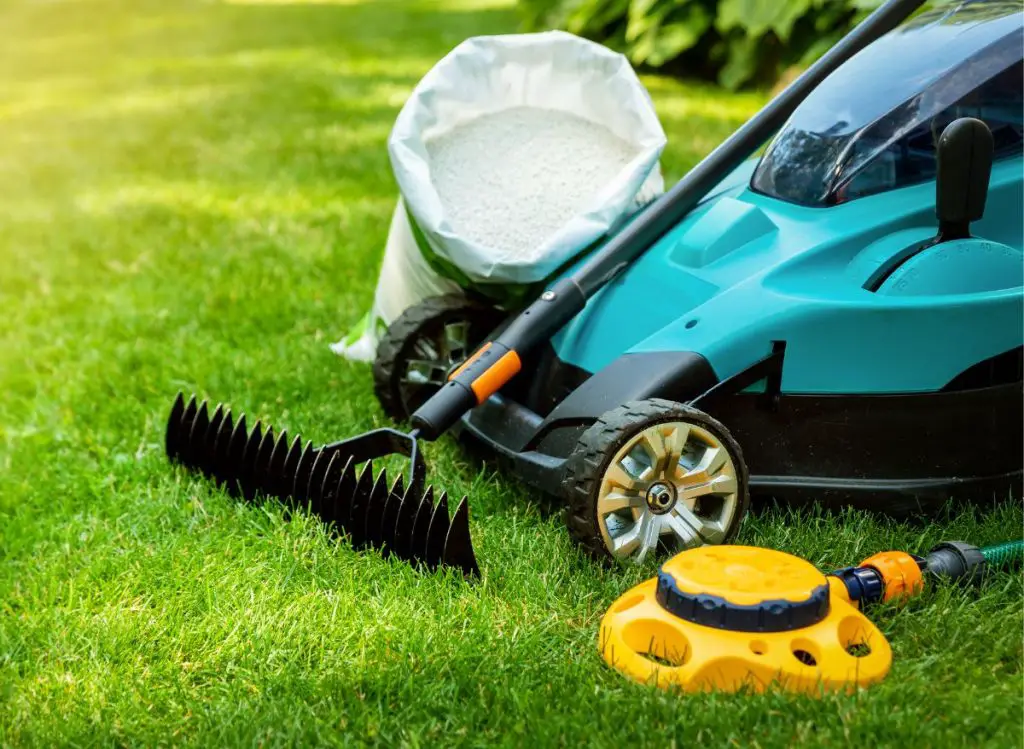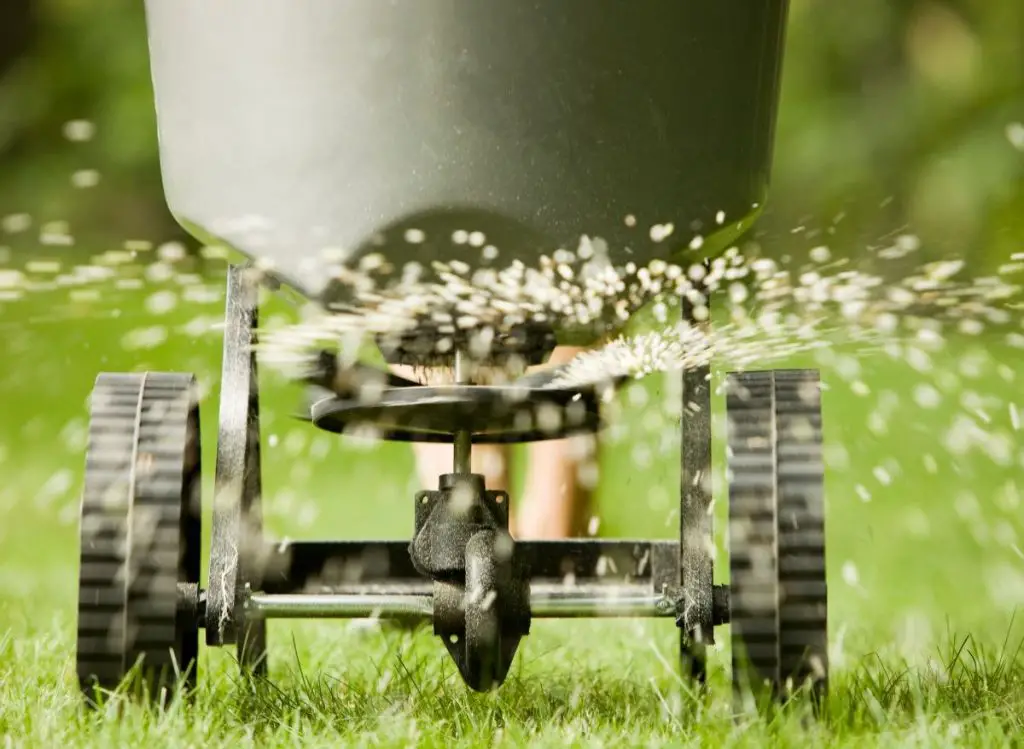This post contains affiliate links.

A lush, green lawn is every homeowner or gardener’s dream, and achieving it demands the right care and attention. And one of the most important aspects of lawn care is fertilization. The right balance of nutrients can promote healthy roots, improve turf density, reduce weed growth, and enhance overall lawn health.
But one question that frequently arises among lawnmowers is: how long does fertilizer last in grass? Generally, fertilizer can last almost forever; however, the length of time it stays in grass depends on the kind of fertilizer.
The table below shows different types of fertilizer and the length of time it stays in grass
| Type of Fertilizer | Length of Time it Stays in Grass |
| Organic liquid fertilizer | 2 to 4 weeks |
| Organic dry fertilizer | 4 to 6 weeks |
| Inorganic liquid fertilizer | 1 to 2 weeks |
| Synthetic dry fertilizer | 4 to 36 weeks |
Read on to explore the longevity of fertilizer in grass, factors that affect its lifespan, and the recommended frequency of fertilization. Read this article if you wonder whether fertilizer and plant food are similar.
What is Fertilizer, And How Does it Work?
Fertilizers are a nutrient-rich substance that enriches soil, providing necessary nutrients to grass and plants for optimal growth. The most common sources of essential nutrients in fertilizers are phosphorus (P), nitrogen (N), and potassium (K). Also, some fertilizers include “micronutrients,” including zinc and other metals essential for plant growth (Source: United States Environmental Protection Agency). A specific fertilizer material mainly depends on the nutrients that it provides.
There are mainly three types of fertilizer (Source: Frontiers):
- Organic fertilizers (manure and compost) are produced from animal feces and plant or animal decayed or decomposed matter.
- Mineral fertilizers (phosphorus and potash) are made from the environment and crushed or chemically treated before application.
- Industrial fertilizers (ammonium phosphate, urea, ammonium nitrate) are created industrially through chemical reactions.
How Long Does it Take to See the Results of Fertilizers?
The impact that fertilizers have on grass growth and appearance varies due to various factors like soil composition, climate, and grass density. In general, after applying the fertilizer to your lawn, it takes about two weeks to see the result of the fertilizers’ initial impact. However, for more long-term results like growth, root development, and maintenance, it can take up to 6-8 weeks after application to be noticeable.
Depending on the type of fertilizer you use, it can take anywhere from one to five days to start seeing results from using lawn fertilizer.
- Fast-release synthetic lawn fertilizers show results 24 to 48 hours after application.
- Slow-release fertilizers generally work more slowly but are less risky to use. Synthetic slow-release work in about 2 to 5 days.
- And organic slow-release versions work in around 2 to 6 weeks.
The most common factors affecting how quickly you see results are the type of plant, soil, temperature, humidity, location in the home, and time of year. For example, in wintertime, you will see excellent results slowly, but it might take a week or two to see noticeable results in the spring.
How Long Does Fertilizer Last in Grass?
The length of time that fertilizers last in grass or soil is a crucial factor in determining when to re-fertilize your lawn. Typically, slow-release fertilizers dissolve and release nutrients slowly over an extended period of time, while fast-release fertilizers dissolve and release nutrients much faster.
Generally, it is recommended to apply slow-release fertilizers because they last much longer than fast-release fertilizers, typically up to 8 weeks. However, fast-release fertilizers can be helpful for grass’s immediate growth boost, and their nutrients tend to last for 2 to 4 weeks.
One thing to remember is that fertilizer is not a one-time solution for lawn care, and it does not last forever but instead has a specific lifespan, ranging from weeks to months, depending on the type, application rate, weather conditions, and soil type.
The two most common types of fertilizers are slow-release and fast-release.
- Slow-release fertilizers release nutrients slowly over time, which makes them last longer, from 2 to 12 weeks.
- Fast-release fertilizers provide instant feeding but have a shorter lifespan of 1 to 4 weeks.

Factors Affecting The Longevity of Fertilizers in The Grass
Note that several factors can impact the longevity of fertilizer in the grass, such as weather conditions, soil moisture, and grass species.
- Dry, hot weather can cause the nutrients in fertilizers to evaporate quickly, leading to a shorter lifespan.
- Cool, moist weather can delay the nutrient release in slow-release fertilizers, extending their lifespan beyond the specified duration.
- Soil moisture also plays a crucial role in the longevity of fertilizers.
- Excessive watering or heavy rainfall can leach out the nutrients from the soil, reducing the fertilizer’s effectiveness.
- On the other hand, inadequate watering can deprive grassroots of water, which may delay nutrient uptake and lead to fertilizer waste. Fertilizing in the fall might cause groundwater degradation, according to Utah State University Extension.
- Grass species also affect nutrient uptake and fertilizer lifespan.
- Warm-season grasses like Bermuda grass, zoysia grass, and centipede grass have a more extensive root system than cool-season grasses like fescue, ryegrass, and Kentucky bluegrass.
- The longer the roots, the more extended the fertilizer will last.
How to Determine When Your Grass Needs Fertilizing?
In general, lawns should be fertilized four times a year with 1 pound (453.6 grams) of nitrogen at each application. Typically, healthy lawns need only one pound of nitrogen per 1,000 square feet of lawn area every four weeks (Source: University of California) Therefore, after the nutrient level, test your soil to determine when to apply the next fertilizer.
To determine if your lawn needs fertilizing, you can use a soil test kit to test the nitrogen, phosphorus, and potassium levels in the soil.
Lawn experts recommend different fertilization schedules depending on the grass type, soil type, and geographical location. In general, warm-season grasses should be fertilized 2 to 4 times per year, beginning in spring and ending in fall, while cool-season grasses require fertilization every 4-8 weeks, beginning in early spring or fall.
However, the frequency and amount of fertilization should be tailored to your lawn’s unique needs. A soil test can help determine your lawn’s nutrient deficiencies and guide your fertilization routine.

When Should You Fertilize Your Grass?
The best time to fertilize your yard depends on various factors like grass type, climate, and time of year. Typically, it’s best to fertilize your lawn when it’s growing actively in warm weather conditions. For cool-season grass, the best time to fertilize is during the fall and spring, while warm-season grass should be fertilized during hot and humid months like June to August.
Keep in mind that over-fertilizing your lawn can cause more harm than good, leading to thatch build-up and runoff.
What to read next:
- Best Fertilizers For African Violets and keep them healthy and blooming!
- 6 Best Fertilizers For Hydroponics (For healthy and faster plant growth!)
- How To Use Coffee Grounds as Fertilizer (Here’s how!)
Wrapping Up
Caring for your lawn is a full-time job, and fertilizing your grass is an essential component of keeping it healthy and thriving. And understanding how long the fertilizer lasts in grass and when to apply it is essential to growing a lush green lawn.
Depending on the type, weather conditions, soil moisture, and grass species, fertilizers can last between weeks to months. To ensure the best results, I encourage you to choose the right fertilizer based on your lawn’s needs and follow a fertilization schedule tailored to your grass type and soil conditions.
The truth is a well-maintained lawn not only adds value to your property but also creates a peaceful, inviting outdoor space.


